The early 20th century was a period of astonishment and chaos, perhaps in a sweet way, because art transitioned into something unusual called Cubism
Renowned painters like Pablo Picasso and Georges Braque would draw art featuring bizarre geometric shapes and figures, which resulted in other famous painters extending their support.
These cubist paintings usually deviated from accurate images, leaving little room for contours and details.
As time went on, a new environment was built, and the works of French artists Paul Cezanne and Fernand Léger began challenging conventional painting techniques.
Below, we’re going to talk about those famous Cubist paintings that helped influence the new generation and endorse the movement.
(Also Read: Post Impressionist Artists: The 7 Founding Fathers Of Modern Art)
Table of contents
- 1. Les Demoiselles d’Avignon, Pablo Picasso, 1907.
- 2. Guernica, Pablo Picasso, 1937
- 3. Weeping Woman, Pablo Picasso, 1937
- 4. Violin and Candlestick, Georges Braque, 1910
- 5. Woman with a Guitar, Georges Braque, 1913
- 6. Portrait of Pablo Picasso, Juan Gris, 1912
- 7. Still Life before an Open Window, Juan Gris, 1915
- 8. La Femme aux Phlox, Albert, 1910
- 9. Girl with a Mandolin, Pablo Picasso, 1910
- 10. Houses at L’Estaque, Georges Braque, 1908
- 11. I and the Village, Marc Chagall, 1911
- Conclusion
1. Les Demoiselles d’Avignon, Pablo Picasso, 1907.

Les Demoiselles d’Avignon was Pablo’s earliest Cubism painting, which gave birth to modern art and was actually a precursor to the idea that later came to be known as Cubism.
It was one of Pablo’s most controversial paintings and the reason being its explicit subject elements and uncommon art style.
This famous Cubist artwork depicted five naked women in a brothel, which apparently belonged to Barcelona. Their bodies are disjointed, and they have unsettling facial expressions.
In the first place, Pablo hadn’t thought of giving it an abstract touch; the idea was to depict a brothel scene with prostitutes and their clients. As he progressed with the work, he changed the initial plan.
When he saw the work, it came out to be an abstract piece with intertwined shapes; the depiction was as evident as African culture was as women at the point would wear African ceremonial masks.
Pablo’s Cubist painting mainly garnered eyeballs for its bold and explicit elements. That’s the reason it was never shown in public until 1916. The first public appearance it made was in a 1910 magazine article.
Pablo Picasso painting is currently located in the Museum of Modern Art, New York.
2. Guernica, Pablo Picasso, 1937
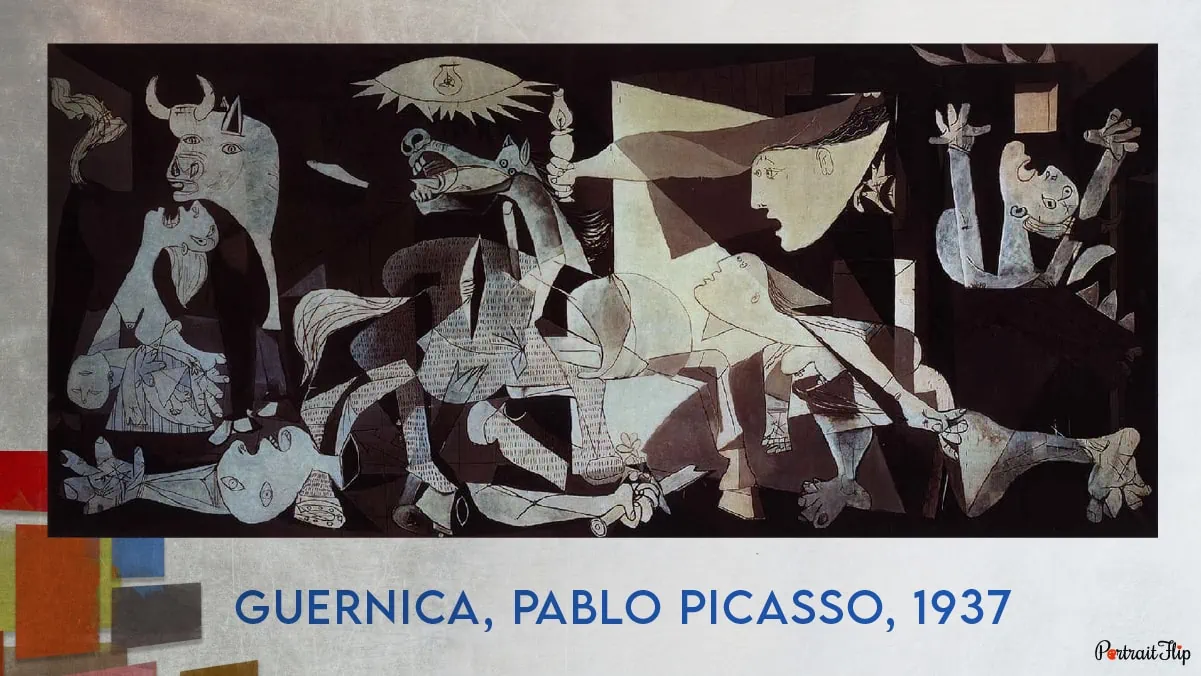
Guernica will always remain Pablo’s finest and most famous Cubist painting.
The artist in this Cubist artwork painted a group of people and animals in a discomforting position.
It is said that scene was from the repercussions of war, which experienced deaths and bloodshed in massive numbers.
When you look at it, you may identify subjects in utter pain and grief, which is why the painting of Picasso was seen as a tragedy of war yet an embodiment of peace.
The Cubism example/work was apparently commissioned by the Spanish government.
And the thought was to spread awareness of the consequences of war and raise some funds at 1937’s Paris World Fair, where it would be displayed.
Unfortunately, it didn’t succeed in garnering attention.
Later, it faced criticism from Tony Shafrazi, who defaced it by spraying red paint.
For many years, its hidden images were a source of contention. You’ll see a skull, which is imposed on a horse’s body, and the bull’s emergence from the horse’ bent leg.
The painting was never put on sale, and that’s probably another reason why it is called a famous Cubist painting.
However, according to some sources, its valuation would probably be over $200 million if it ever went for sale.
3. Weeping Woman, Pablo Picasso, 1937
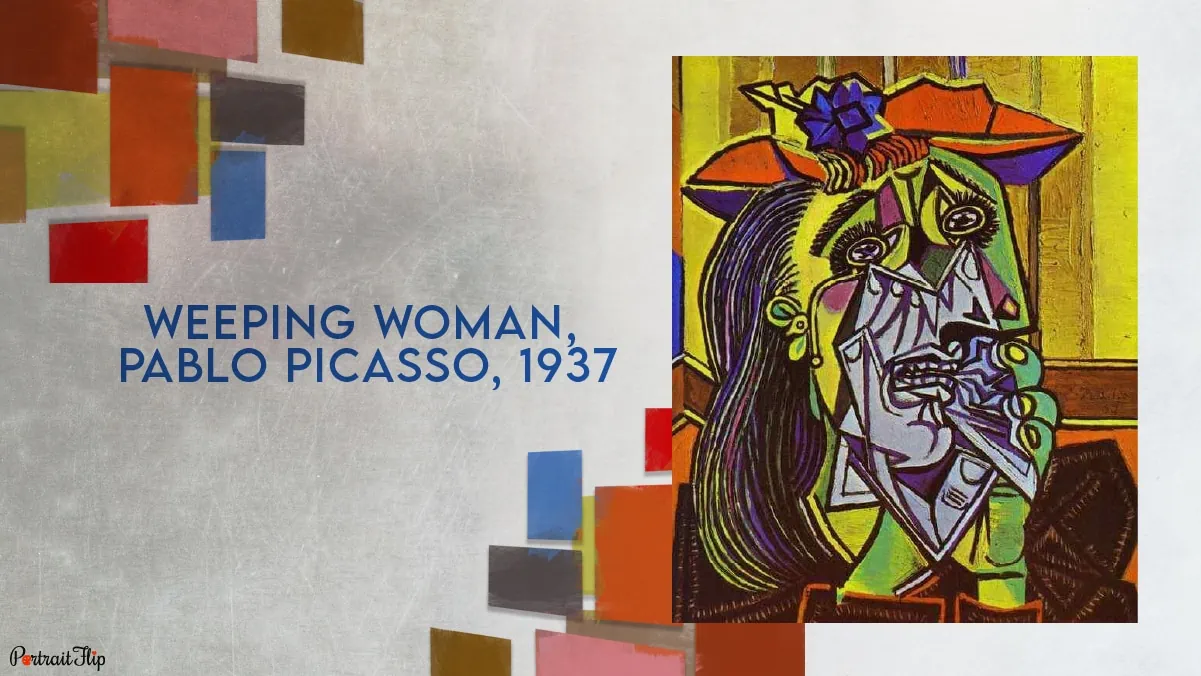
Another Cubist painting by Pablo, which acted as a sign of silent protest against the Guernica bombing, is Weeping Woman.
In this Cubist painting, the artist displayed various emotions—pain, grief, and angst—caused by the bombing attack.
It’s a Cubist picture of a weeping woman, shown in different hues to emphasize her pain.
The use of a model, none other than Dora Maar, who appeared in several of Pablo’s Cubist artworks, is what made this work a famous Cubist painting.
Pablo completed The Weeping Woman in October 1937, a few months after completing his Cubist painting Guernica.
The Cubist painting was often seen as an art piece depicting immense pain and massive loss.
The famous Cubist painting can be viewed at Tate Modern in London.
(Also Read: Picasso’s The Old Guitarist)
4. Violin and Candlestick, Georges Braque, 1910
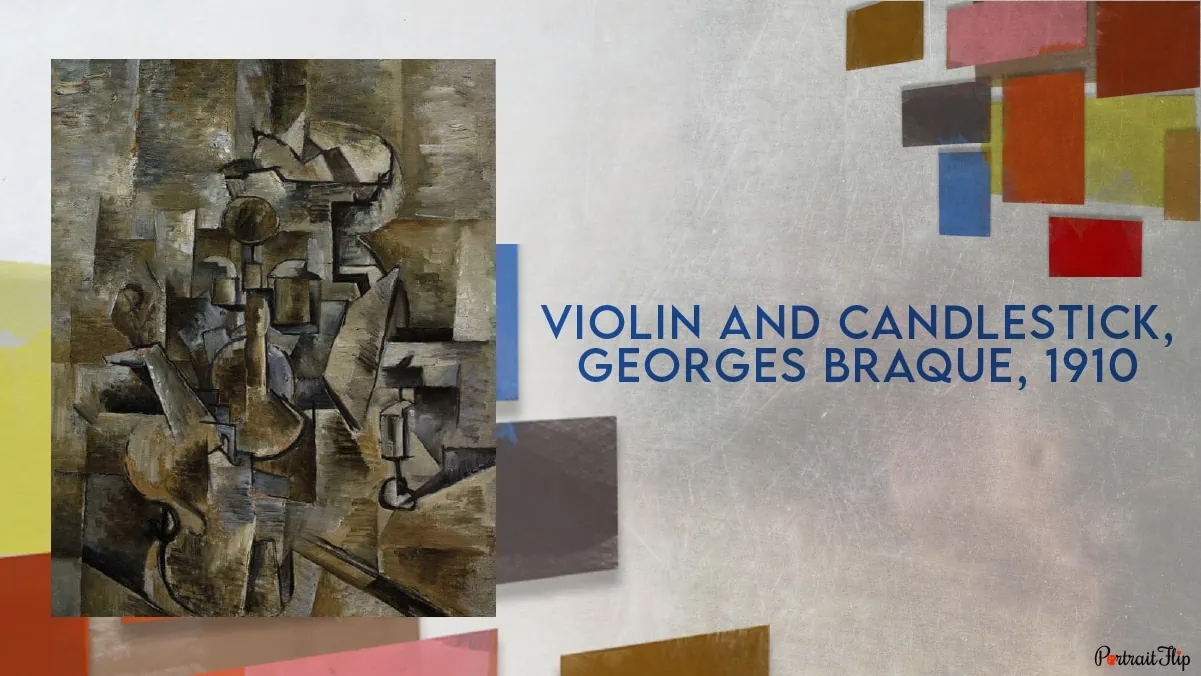
The Violin and Candlestick demonstrate George’s obsession with form and stability.
The famous Cubist painting created an illusion in the viewer’s mind, which was made by many conglomerating subjects, covering their boundaries with earth-toned colors.
The monochromatic styles actually accentuate the subject. One part reveals its meaning, but the other part’s message is difficult to decipher.
One of the famous Cubist paintings hung at the San Francisco Museum of Modern Art is Violin and Candlestick, which clearly reflects Cubist styles.
(Also Read: 12 Surrealist Paintings)
5. Woman with a Guitar, Georges Braque, 1913

It’s one of the largest Cubist paintings by Georges, made with oil and charcoal paints.
The name tells what a Cubist painting depicts. A woman seems to be looking down at the guitar, which is formed with fractured planes and mixed perspectives.
The purpose of adding text to it is to give it meaning.
Despite being broken and fractured, it isn’t chaotic.
This Cubist painting is famous for several reasons: the first being its display of visual dynamics through balance. The other is balancing out figurative and geometric elements.
This famous Cubist painting is at the Centre Georges Pompidou in Paris.
6. Portrait of Pablo Picasso, Juan Gris, 1912
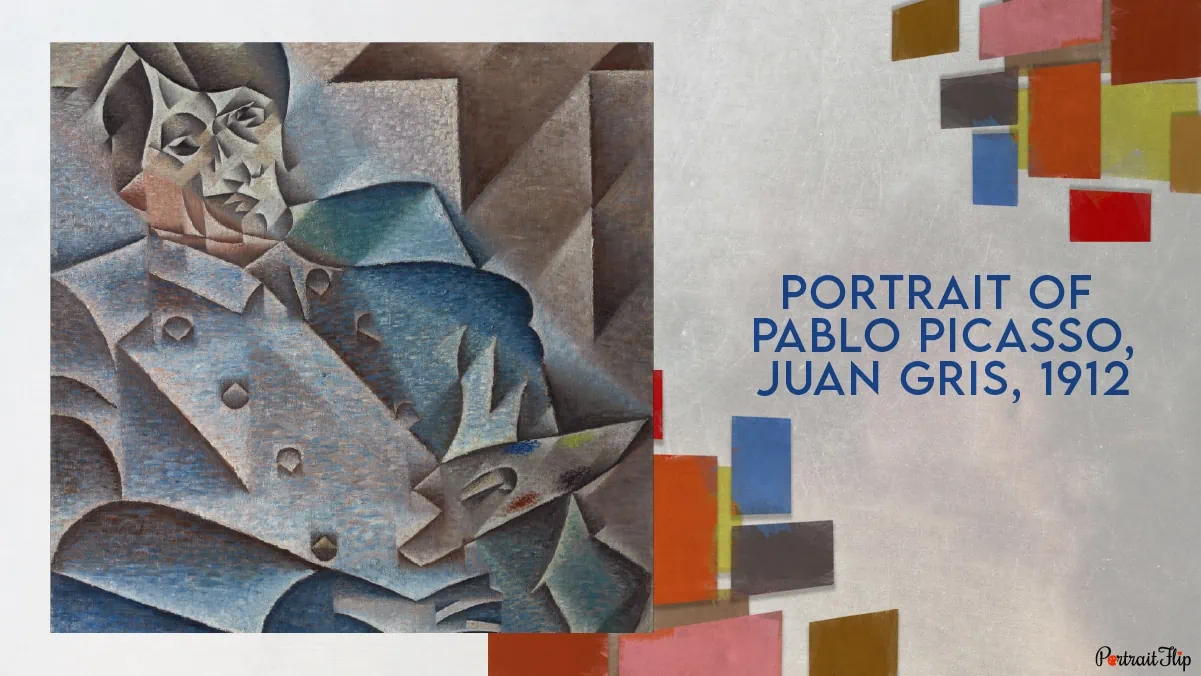
The famous Cubist painting is a tribute to the artist’s mentor, Pablo Picasso.
Because of the more structured geometric composition, the style is reminiscent of analytic cubism.
The artist used clear color panels and let the subject blend with the background.
In order to keep the painting simple, the painter stuck to a limited range of blue, brown, and gray shades, following the dynamics of analytic cubism.
Gris displayed this world-famous Cubist painting in 1912. Not only does this Cubist painting exhibit his maturity, but also his potential.
Its use of text to give context and meaning to viewers makes it one of the most famous Cubist paintings.
7. Still Life before an Open Window, Juan Gris, 1915

Juan Gris created this masterpiece, a Cubist painting, in 1915.
It has the most impeccable features; it combines outdoor and indoor views within the same painting.
The Philadelphia Art Museum owns the synthetic cubism-inspired painting.
The reason it’s on the list of famous Cubist paintings is its composition. Its background elements are clearly identified, whereas the foreground contains still-life arrangements, as the title suggests.
The majority of Cubist painting is dominated by an intense and unearthly blue.
A wide range of elements is displayed at the center, including a newspaper, a wine glass, a book, and other unclear subjects.
The other reason the painting turned out to be one of the most famous Cubist paintings is because of its perfect blend of interior and exterior through interrelated pictorial elements and vibrant colors.
Also Read: Famous Spanish Artists
8. La Femme aux Phlox, Albert, 1910
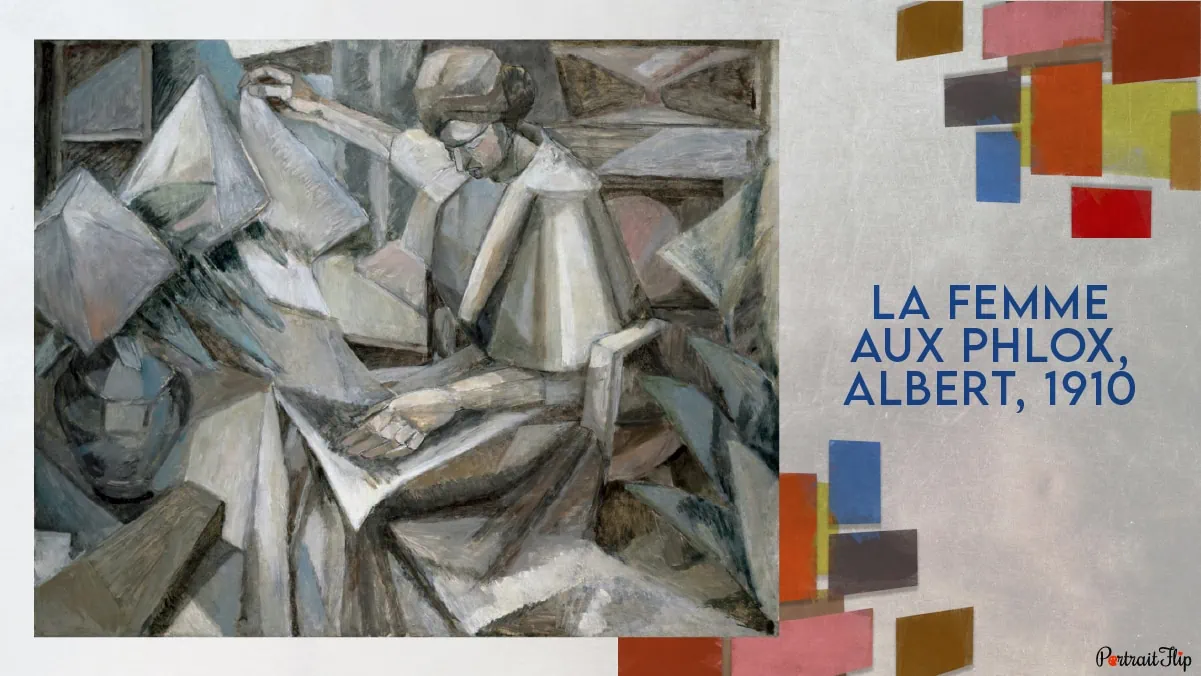
One of the finest examples of Cubist paintings is none other than La Femme aux Phlox.
The Cubist painting depicts a woman sitting in a chair, with her head pointing down and a vase of flowers in her front and on the corner, next to her right foot.
The exhibition where it was first displayed provided a platform for Cubist artists. For the first time, it introduced people to cubism as a group manifestation.
There were over 6500 artworks in the exhibition. Prominent names from the Cubism movement showed up at the venue.
However, the painting garnered eyeballs for the wrong reasons. Perhaps not for the wrong reasons, since room 41, where it was exhibited, was full.
People were storming in and out with indignation, protest, laughter, encouragement, and whatnot.
This will be one of the few famous Cubist paintings that opens the doors to both chaos and compassion.
The French Parliament was in disagreement with the display of cubist artworks. It was told that the cubist painters had collected public funds for their own use—to produce something that’s illogical and baseless.
However, many came forward in support of Albert and other cubist artists, which brought massive attention to this cubist art piece.
9. Girl with a Mandolin, Pablo Picasso, 1910

Pablo’s Cubist artwork wasn’t fully the subject of abstraction. Because some of its elements could be identified with the naked eye.
For instance, the mandolin and a girl playing it are clearly noticed. Girl with a Mandolin was one of Pablo’s more difficult works to decipher.
The birth of Pablo Picasso’s Cubism art took place when he met Fernande Olivier in 1910 during a summer vacation in Cadaques.
Picasso at that point had shifted to analytical cubism from the early cubism phase—the time in which he invested surface ornaments with intrinsic value.
Which is why “The Girl with a Mandolin” is considered the first piece of analytical cubism, where the subjects are being created with geometric planes and shapes.
Pablo was concerned and worried because it had received criticism for devoting of reality.
Although it is partially abstract, it’s still a representation of plasticity.
This stunning piece of Cubism is in the collection of the Museum of Modern Art, New York.
10. Houses at L’Estaque, Georges Braque, 1908
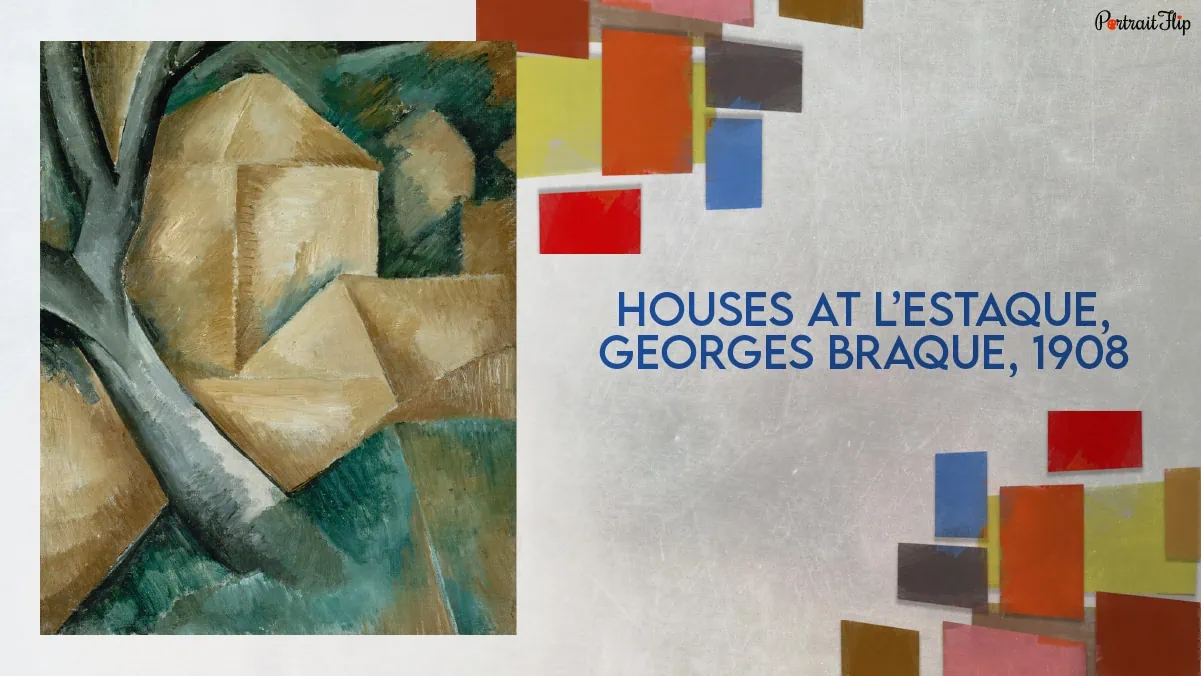
This is one of the famous Cubist paintings by Georges, which raised many eyebrows.
It was said that the cubist painting was Georges’ official entry into real Cubism. However, some painters claimed that the painting was the first Cubist landscape artwork.
Like other Cubists’ paintings, the artwork consists of an unearthly blue tone, geometric planes, cubes, and shapes.
The painting, which depicts the French village of L’Estaque, was the main subject of many paintings at the time.
The cubist painting didn’t perform well. Also, it was knocked back by the Salon d’Automne.
Not only that, the jury members—Guérin, Marquet, Rouault, and Matisse rejected Braque’s six landscape paintings.
11. I and the Village, Marc Chagall, 1911

The Cubist painting, “I and The Village,” was created after Marc moved to Paris from Russia.
The famous Cubist painting is full of imaginary elements overlapping each other. You’ll see a man with a green mask looking at the goat, whose cheek shows a goat being milked.
In the foreground, there’s a woman upside down playing violin and a man marching towards her with a scythe over his shoulder.
It’s said that the famous Cubist painting depicts the artist’s childhood memory of Russia.
This Cubist art piece received attention for its fine depiction of human nature, and its use of colors and figurative elements.
Today, it’s in the collection of the Museum of Modern Art, New York.
Conclusion
The idea, that sprouted from Cezanne’s work turned out to be a whole movement, producing tons of Cubist artwork.
Although the prime movers, Pablo and Braque, contributed massively to the movement and reach of the style, other artists like Juan, Albert, Salvador, and others also played a remarkable role in it.
Hence, many artworks are considered to be the finest examples of Cubist work, which we included on this list.
I hope you have found these famous Cubist paintings valuable and learned how they made the movement popular.
If you liked the artwork and would like to have a replica of famous artwork at your home, you can connect with us.
We produce replicas of renowned artworks, be they cubist paintings, abstract paintings, or nude paintings.
Frequently Asked Questions
Pablo Picasso and Georges Braque were the biggest contributor to Cubism movement.
The two most controversial Cubist paintings were Les Demoiselles d’Avignon and Guernica.
The Portrait of Pablo Picasso was the most famous Cubist painting by Juan Gris.
Georges Braque made the Houses at L’Estaque, the first Cubist landscape painting.





